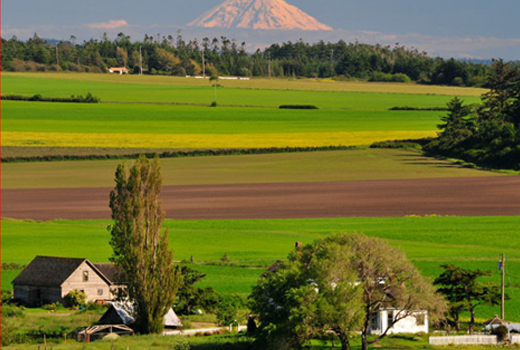A Community of Collaboration: Whidbey Island & Sustainable Agriculture
Industrialization of agriculture has taken a large toll on small, family farms. In the last century, the number of farms fell nearly 65 percent, and the farm labor force dropped from 41 to 1.9 percent. Today, just one in 10 small farms produces enough income to support a family. But small farms play a significant role in the economic, cultural and environmental health of a community. For rural Whidbey Island in Washington State’s Puget Sound, fourth generation family farmers, as well as a new breed of greenhorns, are recapturing the island’s farming heritage, creating a fresh food culture supported by diverse crops, seed research, market demand, delivery systems and agritourism.
On the short ferry ride to Whidbey Island, across the scenic waterway separating it from the mainland, it is not hard to imagine the lure of this Northwest isle for the first European pioneers. Surrounded by the protective waters of Washington State’s Puget Sound, and lying in the rain shadow of the Olympic Mountains, Whidbey has natural prairies, rich black loam, marine air and a temperate climate. It is a place the first permanent settler, Colonel Isaac Neff Ebey, called “a paradise of nature.” The island nearly begs to be farmed.
The earliest peoples understood that, too. In addition to coves and bays rich with fish and shellfish, the Lower Skagit Indians found the island’s prairies ideal for growing bracken fern, nettles, berries and camas lily. The Donation Land Claim Act of 1850 brought thousands of settlers into the area. The fertile land and protected harbors allowed new pioneers not only to become self-sufficient but also to find a demand for their goods in nearby towns, including Port Townsend to the north and a fast-growing Seattle just 30 miles to the south.
Trends in Farm Production
The island proved hospitable for raising crops and livestock. By the late 19th Century, most farmers were quite prosperous. Farm life was good and yielded bountiful harvests, relying only on animal power, manual labor, sunshine and rain. It was a circular and renewable system based on the seasons with little gone to waste. Scraps became compost or food for animals, and seeds were harvested and replanted. Pasture health was replenished by turning it over to the farm’s chickens or cattle and their scratching, grazing and rich manure.
Whidbey Island became the main source for butter and potatoes throughout the Puget Sound region. One grower became nationally famous for raising a record 117.5 bushels of wheat per acre. And Greenbank Farm, first established as a dairy around 1900, eventually became the largest loganberry farm in the U.S.
However, with industrialization of farming and advances in refrigeration and transportation, Whidbey’s agriculture community faced more competition, lower prices and decreasing income. With chemical fertilizers, irrigation methods and genetically modified or hybrid seeds (first introduced during the
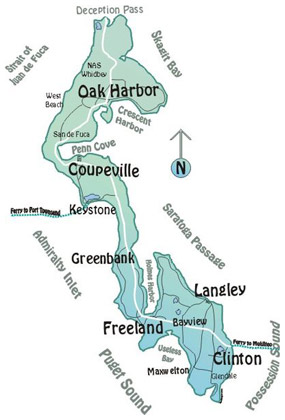
Credit: Wikipedia |
Whidbey Island is in northwest Washington.
Depression), huge farms on the mainland were able to increase production significantly, thus squeezing greater amounts of grain and produce from a single monoculture acre – seemingly defying the cycle of nature and what the earth had been willing to give on its own.
In early 1942, many farmers at the north end of Whidbey Island sold their land to the federal government and went to work building the new U.S. Naval Air Station and Seaplane base in Oak Harbor. While the base brought jobs and growth, agriculture on Whidbey waned, and much of the island became better known as a weekend getaway of second homes for Seattleites.
Today, few small, working farms are left in the United States; the ones that have survived do so by providing things big industrial farms cannot. And this is good news because of a fast-growing trend for healthier foods. Many reasons exist for this rise in healthier eating: concern about chemicals used in processed foods, uncertainty surrounding genetically modified foods, and the rise in allergies and obesity. Consumers are also developing a greater desire to know where food comes from and to eat more like a locavore (one who eats foods grown locally) – fresh, organic, seasonal and sustainable. Perhaps the most compelling reason is taste. For anyone who has grown weary of tomatoes, apples or strawberries with no distinct flavor, scent or texture, farm fresh produce is pure eating pleasure.
Preservation of Island Farmland & Culture
Despite the national shift away from small farm economies and livelihoods, Whidbey Islanders refused to let their agricultural traditions disappear. Knowing the uniqueness of its prairie and small farms, they sought protection for the land and its culture. In 1978, Ebey’s Landing National Historical Reserve was established, which is the nation’s first such reserve created by the National Park Service.
As a working rural landscape, it encompasses 17,572 acres of privately owned historic farms in central Whidbey Island. It also includes a seaside town (Coupeville), native and pioneer land-use traditions and ecologically significant areas like Penn Cove. The Reserve helps guarantee stewardship of the rich alluvial soil, and it preserves the more than 160-year history of small farm use. Today, many farmers of Whidbey Island still plow donation land claims established by their families in the 1850s.
However, some areas were less fortunate. In 1997, Greenbank Farm was about to be sold for a housing development. Swiftly responding to the threatened loss of a historic property that was part of Whidbey agricultural traditions, a community-based consortium consisting of the Nature Conservancy, Island County and Port of Coupeville purchased the 522-acre property, forever protecting the historic land.
Greenbank Farm is now a non-profit and agritourism attraction with a seed stewardship center, 70-member community supported agriculture (CSA) program and a farmer training school where greenhorns (first generation farmers) can attend a seven-month residential program to learn technical and business skills needed to run a small-scale organic farm. It is also currently sponsoring a new CSA project, the certified organic Deep Harvest Farm, which is experimenting with winter produce.
Cluster Support Systems for Sustainable Agriculture
While hobby farms and roadside stands selling eggs, berries and honey are in abundance, a greater food systems cluster has developed, which consists of producers, processors, distributors and markets. This cluster enables Whidbey’s 21st-Century farmers to resurrect farming traditions and to grow triple-bottom line endeavors: farms that benefit people, place and profit.
At the heart of Whidbey’s sustainable agriculture are the producers – farmers and growers. One of the most visible is Georgie Smith of Willowood Farm on Ebey’s Prairie, a fourth generation farmer who grew up on the 20-acre plot she now works. Smith, like many other island farmers, opted out of the often costly and time-consuming organic certification process. Instead, she uses healthy farming practices, such as minimal tillage, diverse crops, compost instead of chemical fertilizers, crop rotation and cover crops.
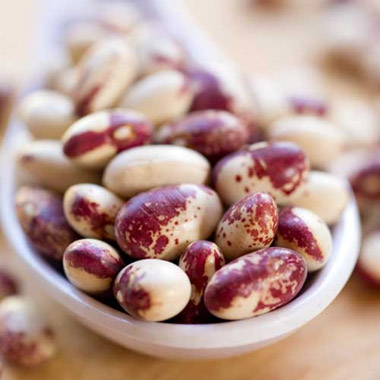
Credit: Willowood | Farm Rockwell Beans
Using nature as her guide, Smith has extended her growing season to as long as 11 months. At a late December 2012 farmer’s market, her offerings included several types of squash, onions, potatoes, greens and artichokes. She also offered five kinds of dry beans, including the Rockwell bush bean, which is native to Whidbey Island and first grown in the 1880s.
The area also has plenty of new, full-time farmers like Patty and Loren Imes of Quail’s Run Farm, who left the corporate world 10 years ago. They work two of their 38 acres at a time and grow a wide range of heirloom and open-pollinated produce for their 40-member CSA, farmer’s markets and local chefs. The Imes are experimenting with beans and grains, including rye, which a local baker uses whenever it is available. They also raise a small herd of Angus cattle, an integral part of the farm’s two-year rotation cycle of grazing and fertilizing pastures and planting areas. Chickens and ducks have jobs to do, too, eating insects and slugs, and scratching and fertilizing topsoil.
“At one time, we had 38 head of cattle but reduced it to 13 after determining what the land could self-support,” said Loren Imes. “We didn’t want to have to buy feed from outside sources, which could possibly contain herbicides that could wind up affecting the entire farm.”
Niche Opportunities & Interests
Vineyards & Wineries. Whidbey Island is home to several vineyards and wineries, such as Comforts of Whidbey, which makes white wine from its own sustainably grown grapes. Carl and Rita Comfort are first-generation vintners who cultivate 6,000 plants on four acres – mostly Siegerrebe, Madeleine Angevine and Madeleine Sylvaner varieties – that flourish in Puget Sound. The Comforts are learning environmentally friendly growing practices through research and regional training centers. For instance, instead of burning vines after pruning, they mulch and use them as ground cover in the vineyard rows, which protects plants during cold, wet winters.
Aquaculture. Farming isn’t all about the rich dirt on Whidbey Island; the geographical form and location of Penn Cove is uniquely suited to aquaculture as well. The cove captures fresh mineral waters from the Cascade Mountains, and the rain shadow turns the bay into a bowl of rich plankton soup for shellfish to feast on, thus eliminating the need for additional feed or fertilizer. In turn, the shellfish protect the health and habitat of the marine ecosystem as they naturally filter the water. Penn Cove Shellfish operates a sustainable mussel farm in those sheltered waters. Started in 1975 by the Jefferds family of Whidbey Island, each of the four dozen floating mussel rafts, visible from the village of Coupeville, supports between 900 and 2,500 mussel lines, yielding up to 50 pounds of shellfish on each line. From seed, the mussels take about 14 months to reach a harvestable size, which creates an ongoing rotation among the rafts between juveniles and those ready for market. Penn Cove Shellfish is now the largest shellfish farm in the United States. The company grows and harvests two million pounds of highly prized mussels every year that are shipped all over the world. The company employs 65 people, who are kept busy every day of the year.
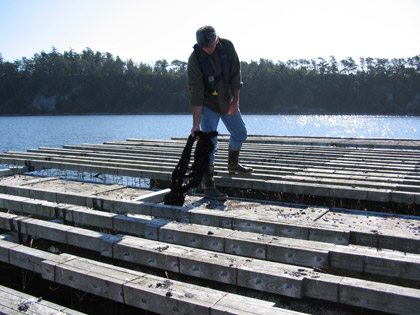
Credit: Nan Devlin | Juvenile mussel line on raft of Penn Cove Shellfish.
Processors & Commercial Kitchens. Processors and commercial kitchens have grown quickly in the last five years. One kitchen just opened in Coupeville at the new Lavender Wind Farm gift store and is owned by Sarah Richards. She uses the sustainably grown lavender from her 8-acre farm in Ebey’s Preserve to make bakery items, desserts, soap and lotions, and cleaning products. Richards also makes the kitchen available to other processors.
Distillery. Whidbey Island Distillery is the first legal still on the island. Steven and Beverly Heising, the owners, uncovered and use a recipe for loganberry liqueur once produced by Greenbank Farm. Washington State requires craft distilleries to use 51 percent or more of Washington-grown products in spirits production. Therefore, the Heisings purchased 300 pounds of local berries for their first run of about 1,200 bottles. And they also purchase surplus wine from local winemakers to distill the base brandy for the sweet red liqueur, with remainders going back to wineries for making port.
Cheesemaking. Glendale Shepherd Farmstead is tucked into a cool forest at the south end of Whidbey overlooking Saratoga Passage. This family-owned and operated Grade A dairy farm, which has been in the Swanson family for three generations, is committed to sustainable agriculture practices and production of fine sheep milk cheeses. Cheesemaker Lynn Swanson follows recommendations for managing waste produced by her sheep, and the milking barn operates on solar energy. In addition, the farm was recently certified as Animal Welfare Approved after an extensive audit of Swanson’s farming practices to ensure the sheep are raised humanely.
Delivering the Goods
Farmers markets abound on Whidbey Island with at least one in every village, but they usually operate once a week so access can be limited. However, several independent food stores are also a source for local produce. Lodging establishments, including Eagles Nest Inn in Langley and Lovejoy Inn in Coupeville, serve local eggs, cheese, bread and produce for breakfast. In addition, home cooks can order from a weekly “fresh sheet” delivered by Whidbey Green Goods, with selections ranging from lettuce and blueberries to herbs and locally roasted coffees. With more than 750 customers, Whidbey Green Goods operates like a combination CSA and grocery store on wheels.
Fine dining establishments on the island and in Seattle fill their menus with local shellfish, beef, vegetables, fruit, cheese and wines. Chef Scott Fraser of Fraser’s Gourmet Hideaway in Oak Harbor lists the names of the farms he buys from on his menu. Renowned chef Matt Costello of the Inn at Langley builds his entire artful weekend menu around local, seasonal offerings. Both Fraser and Costello have been influential in creating a distinctive Whidbey Island cuisine that is capturing the attention of foodies who appreciate the farm-to-table experience.
Associations & Research Development
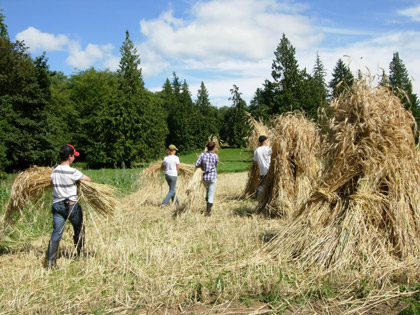
Credit: Patty Imes | Rye harvest at Quail’s Run Farm.
In addition to community and business support for local farm goods, farmers enjoy the active engagement of agricultural networks and regional research programs. Washington State University Extension Service in nearby Mt. Vernon provides ongoing agricultural education and conducts extensive research. One current project is to identify grains suitable to western Washington that will support sustainable cultivation and investment opportunities. Demand for local grains is coming from a variety of sources, including cereals for livestock feed, artisan breads, brewing and distilling. The Organic Seed Alliance in Port Townsend, Washington, is establishing research models for developing organic seed. With the Clif Bar Family Foundation, they recently rolled out the Farmer Seed Stewardship Initiative to recognize farmers as seed innovators and producers. And the Northwest Agriculture Business Center (NABC) helps “agripreneurs” with hands-on workshops and consultations. Recent classes included advanced skills in cider making and meeting regulatory standards for dairy products. NABC also annually produces a self-guided touring map of Whidbey farms for visitors.
Whidbey Island Conservation District (WICD) provides technical assistance for farmers to enhance productivity and to protect natural resources. The Agency helped cheesemaker Vicky Brown of Little Brown Farm determine the animal load for her property, develop a nutrient management plan and estimate the amount of manure her goats would produce along with its correct disposal.
To help market the plethora of agricultural goods, the Puget Sound Food Network created an online food hub to connect food producers and products to buyers. And four years ago through NABC farmers established the Whidbey Island Grown brand to increase awareness and consumption of local foods.
Agritourism in Paradise
With all this going on, Sherrye Wyatt, marketing director of Island County Tourism, saw the potential that agritourism could bring to Whidbey’s economy. Since the recession, fewer families are taking expensive trips and are instead seeking close-to-home, affordable adventures offering authentic experiences. Located just one hour from Seattle, Whidbey Island is perfectly suited for those visitors.
Working with WICD and organizers of the annual Whidbey Farm Tour weekend, Wyatt invited travel writers to visit farms, meet farmers and taste local wines and food. The resultant publicity has helped to jumpstart a new agritourism and culinary initiative for the county – one that has brought exceptional results. Since 2009, each of the farms on the weekend tour sees close to 500 visitors. And, Island County has enjoyed a 30 percent increase in hotel receipts and visitors, bringing much needed tax revenue to benefit local programs. In addition, the culinary spotlight is shining brightly on local chefs and foods.
At its peak, Whidbey Island boasted more than 1,700 small farms. Today, Island County, which also includes the smaller Camano Island, is home to 460 working farms with the majority less than 50 acres in size. The area also consists of nine wineries, 13 fiber farms (alpaca, llama, sheep and goat), eight beef farms, five flower farms, six farmers markets and a community committed to preserving its farm culture.
“It’s as if everyone knows they live in paradise,” said a Whidbey Island artist known for her paintings of farm scenes. “We never take for granted what we have here, and we never forget our responsibility to protect it.”

